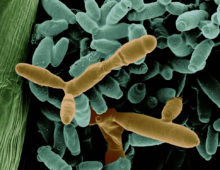Comparative and Population Genomics of Xylariaceae
Despite evidence that endophytes play a critical role in plant-microbe interactions, they are poorly represented in genome databases. Leveraging our unique culture collection, the team proposes a genomic survey of the Xylariaceae, one of the largest and most diverse families of fungi made up of endophytic, pathogenic, and saprotrophic (including wood degrading) species. Our project… [Read More]


